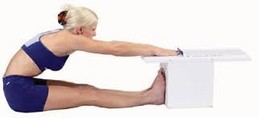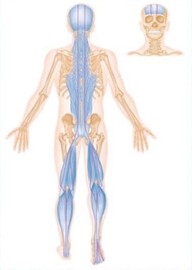
The research, published in the Journal of body work and movement therapies, aimed to see what the immediate effect of a single application of self-myofascial release (self-massage) on the plantar aspect (underside) of the foot was on hamstring and lumbar spine flexibility.
Two groups or people were randomly assigned to either the soft tissue group or a control group. Flexibility was tested using the Sit and Reach Test (SRT). In this test, people sit on the ground with legs straight and using a sit and reach box lean forward as far as they can. This test is a common test for flexibility, especially of the lower back and hamstrings.
Both groups initially performed the test to get a baseline reading. The control group then used a tennis ball and worked the muscles and fascia under each foot by rolling the tennis ball under the foot. They did this for 2 bouts of 2 minutes (1 for each foot). The researchers then re-tested the Sit and Reach Test.
The Results
The researchers found that the Sit-and-Rest Test increased significantly in the group that did the soft tissue massage (increase = 2.42cm) compared to the control group (increase = 0.83cm).
Why this worked
The researchers said that the mechanisms by which this worked is not fully understood but thought it may be due to the posterior chain of muscles. The idea of ‘anatomy trains’ were developed by Tom Myers. It is a way of thinking which looks at the body as a series of interrelated chains and not just a system of individual muscles. The posterior chain starts under the foot and runs up the back of the legs to the lower back and up to the back of the head. If you think of this ‘train’ then you can see how working under the foot may affect the hamstrings and the lower back. The image below shows what the Posterior Chain of muscles looks like.
What I make of this
This is just another interesting piece of research that shows how interconnected the body is. It also shows how you cannot just focus on one area of the body and forget the rest. If you have tight hamstrings, it may not just be you have short hamstrings. It may be that you have foot problems associated with a postural deficit and simply improving foot function and posture will fix you tight hamstrings. Everyone is different and need to be assessed properly.
5 simple ways to help improve your foot function
- Loosen up the muscles and fascia under the feet using a tennis ball, or to get in deeper, a golf ball. Working on the calves is also useful.
- Get your feet adjusted by a chiropractor. There are more bones in the feet than there are in the spine so making sure they are working well is very important.
- Try walking around in bare feet frequently. Our feet are designed to move. Having them supported in shoes all the time is not ideal.
- While in bare feet, practice balancing one foot. Standing on one foot will help ‘wake’ the foot up and get the small muscles firing. There are plenty of ways of making this harder. Ask me how.
- Aim to walk with your feet straight ahead. Your feet function optimally when facing straight ahead. Try to avoid walking with the feet positioned outwards or inwards. It may feel weird initially but it is worth practicing.
References
- Grieve, R et al. The immediate effect of bilateral self myofascial release on the plantar surface of the feet on hamstring and lumbar spine flexibility: A pilot randomised controlled trial. Journal of body work and movement therapies
- Mowen K. Anatomy trains keep bodyworkers on track. www.massagetherapy.com




 RSS Feed
RSS Feed


